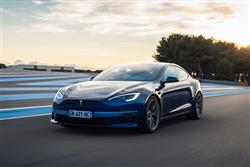Tesla Model S - ABC Leasing
How will you view?
This is a sample, showing 30 seconds of each section.
SMART CHARGER(some text hidden)
By Jonathan Crouch
Ten Second Review word count: 80
Tesla's Model S is the brand's original EV, an electric large luxury fastback with around 400 miles of range. In this improved form, it's now sleeker and more sophisticated and has almost supercar-style acceleration. In its current form, the car has been updated with a completely new interior and there's now a choice of either 'Dual Motor' or 'Plaid' AWD variants with 100kWh battery outputs. Here's what the future looks like - and it might just be cause for celebration.
Background word count: 253
Would it be too much to call Tesla's Model S a 'game changer'? We don't think so. Back in 2012, this car launched what is now the world's best known automotive EV brand on an unsuspecting world. It shocked the established brands into getting on with the electric era. And it was a luxury executive EV benchmark that others aspired to for nearly a decade, originally engineered with a goal of creating the best car in the world. You'd think though, that after well over ten years on sale, it'd be time for a completely new design to face a flood of fresh rivals. Instead, what we got in 2023 was this heavily revised version of the original. Will that be enough for Tesla in this segment? That's what we're here to find out. This wasn't the first Model S update - the earlier one happened in 2016 when the car lost the original version's fake grille. But it's by far the most significant change to this Tesla yet - as you'd hope, after a decade on sale and with several hundred thousand examples pounding global roads: not that you'd know that from the remarkably subtle exterior differences between this current-era car and the original. But look a little closer. There's a completely redesigned cabin; the body structure's different, the suspension's been re-engineered and the complicated confusing range of single motor versions have long been dropped, with the Dual Motor variants that remain now using a larger and completely different 100kWh battery pack.
Driving Experience word count: 464
In both its guises, the Model S is very fast indeed. But abruptly striking speed in a luxury sporting EV like this has a very short shelf life of admiration. It wows you on the test drive and in the first few days of ownership, but then on public roads becomes something of an irrelevance - or even an irritation. What are the longer-lasting driving virtues you'd ideally be seeking from a big six-figure luxury segment EV contender like this? Well we'd be looking for hushed refinement, a smooth step-off the line, an emphasis on mid-range rather than start-off acceleration and, around the turns, something of the handling agility of a smaller car. In both the standard Dual Motor and top Plaid forms that make up this updated range, the Model S delivers all of these things and more. But there's now the disadvantage of the left hand drive-only format that the US brand now mandates for our market. Given the size and width of this car, that can make dealing with corners at speed on narrower British roads something of a confidence test. Particularly in a car with this much power. We can't imagine why the standard Dual Motor version wouldn't be quite sufficient for anyone shopping in this segment. Its AWD system uses a motor on each axle, together developing 661hp, allowing for an uber-rapid 3.1 second 0-60mph sprint time and a very un-EV-like (limited) top speed of 155mph. But there's another, wilder option. If like Elon Musk, you're the kind of person for whom too much is never enough, then only the top tri-motor Plaid version we tried will do. An extra motor added onto the rear axle boosts total power output to an astonishing 1,020hp, with a scarcely believable 1,420Nm of torque on tap. And as a result, Tesla claims a 0-60mph time of just 1.99 seconds, which (should you be able to replicate it) would make this the world's fastest-accelerating production car. Ride quality in this updated design is massively better, even on this test car's big 21-inch wheels, a crucial improvement because for all its speed, this is a luxury conveyance first and foremost. To achieve this, Tesla's standardised air springs and completely redesigned the suspension, changing it from a four-link to a more sophisticated five-link set-up. Not so sophisticated is the steering set-up. The optional provision of this steering yoke suggests a sophisticated drive-by-wire system but that's absent, as is much sense of feel from the rack through the corners, no matter which of its three provided settings you select. Also strangely unsophisticated is the braking set-up (which can't combine friction and regen braking); and the energy harvesting system (which can't be varied in strength like it can be with rivals); there's just a single 'one-pedal' option.
Pictures (High res disabled)

.jpg)
.jpg)
.jpg)
.jpg)
.jpg)
.jpg)
.jpg)
.jpg)
.jpg)

Scoring
Category: Compact Car
| Performance | |
| Handling | |
| Comfort | |
| Space | |
| Styling | |
| Build | |
| Value | |
| Equipment | |
| Economy | 100% |
| Depreciation | 80% |
| Insurance | 70% |
| Total | 75% |